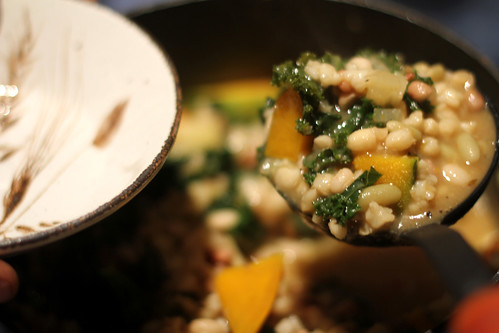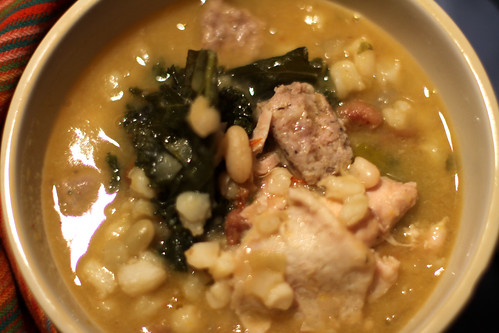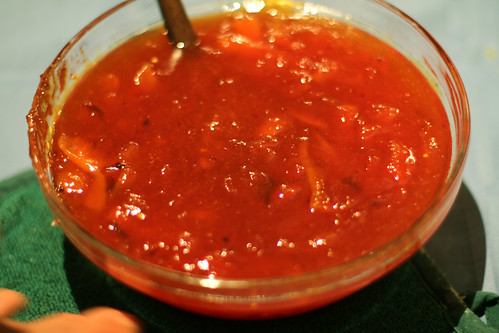 Note: In 2013, the year after we cooked this meal, this country changed its official name in English to Cabo Verde.
Note: In 2013, the year after we cooked this meal, this country changed its official name in English to Cabo Verde.
For some countries it's tough to nail down which dishes to cook, but Cape Verde, a cluster of islands off the coast of Senegal, offers an unmistakable national dish. The cachupa is a stew based on dried corn and beans, and what goes in beyond that depends on your family history, socioeconomic status, and whether the rains came.
To inventory the sorts of ingredients that typically go in a cachupa is to trace the extent of the Portuguese empire: corn, dry beans, and manioc from South America; plantains from Southeast Asia; kale, cabbage, and sausage from Europe; and yams from Africa. Conveniently enough, the Spanish colonial pantry overlaps substantially, so I was able to find just about all I needed at the strip of Mexican markets on 5th Avenue in Sunset Park. The only ingredient that I was nervous about finding was unground corn with intact germ (e.g., not nitxamalized), and although dozens of searches on Google and a visit to Brooklyn Kitchen didn't turn up anything, I found it in the Goya aisle of the local Met Foods supermarket. You know that song "Jimmy Crack Corn?" Well, this is that sort of corn.
I should also note that the U.S. is home to a long-established Cape Verdean community. Most of them are in New England, the core having made its way here on American whaling ships in the mid-19th century that often picked up crew in Cape Verde.
Tonight's adventuresome guests were Tammy, Raven, Dan, Chrys, Sean, Tennessee, and Lemuel, who brought lots of gorgeous Cape Verdean music — if you like the sounds of classic Brazilian crooners, you're sure to love it too.

Cachupa rica | Corn, bean and meat stew | Recipe

There are many levels of cachupa-making, depending on how well-off you are and how hearty you want to eat. A cachupinha might be little more than corn, beans, and salt pork, while a cachupa rica can be a wonderland of flora and fauna, and that's what I set out to make.
There's dozens of recipes for cachupa rica on the internet, especially if you search the Portuguese web. I chose to use this one as my base, while mixing with a half-dozen other recipes I found. Here's the mods I made:
- In the spirit of "use what you've got" that is at the core of stewmaking, I substituted the beans I had in the pantry (navy for the stone beans, flageolet for the limas, and cariocas (left over from Brazil!) for kidneys).
- There's so little agreement on what meat to use, so I didn't take the salt pork as gospel. Instead, I used most of a chicken that I'd butchered earlier in the week at a knife skills class, and also threw in some pork spareribs, both of which I marinated the night before in various fresh herbs from the garden. I also added a fair amount of salt to the stew to compensate, but not enough since most people added more salt!
- In addition to the tangy, red choriço, I got some linguiça (aka longaniza), a more garlicky sausage, but left out the blood sausage since some folks don't like that.
- Instead of cabbage, I used kale, since I had a ton on hand.
- Taking yet another cue from other recipes, I put in some chunks of peeled manioc (aka yucca or cassava) and white sweet potato.
- The recipe doesn't specify the number of onions; for the quantity described I used about two medium onions and it turned out fine.
- Finally, with the carcass of that butchered chicken, I made a broth, that I used in place of bouillon.
- I also made a vegetarian version exactly like the meat-based one but, well, without the meat, with a veggie broth, and a higher proportion of veggies.
Pudim de queijo | Cheese custard | Recipe

In contrast to the messload of ingredients in the stew, this custard is just three ingredients: fresh cheese, sugar, and eggs.(OK, a bit of cheating: the burnt sugar requires a bit of oil to make. The custard, which I ended up baking at 350° for about 45 minutes, turned out lovely, rich, and tastier than you'd expect from such a basic assortment of inputs. And with all the leftover egg whites, I made some chocolate-orange meringues, which have nothing to do with Cape Verde but were tasty all the same.
Doce de papaia | Papaya jam | Recipe

I kept seeing this recipe pop up, so I had to do it. Most recipes implied that you need a fairly unripe papaya, but I couldn't find one so I just made this with a big ol' normally-ripe papaya. We cooked it all throughout dinner, so by the time dessert came around the dish got really red, the sugar got thick and even a bit caramelized, and it was a marvelous topping for the pudim. It's also versatile: we had it on french toast with yogurt for brunch the next day, and it was awesome.
That's it for this little island country. Next weekend we're back on the African mainland, to the heart of it in fact with the Central African Republic. We've been planning the recipes with some pretty knowledgeable sources that we'll tell you all about next time!
Photos by Laura Hadden, who's looking forward to putting papaya jam on everything for the next few weeks.